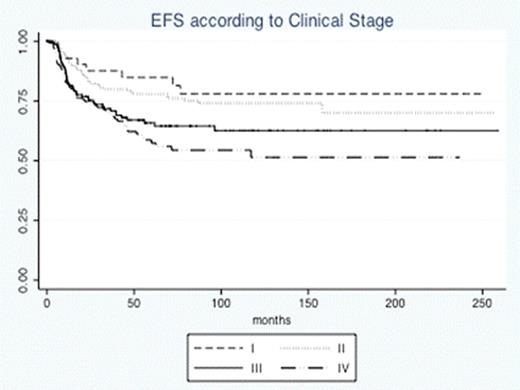Abstract
Abstract 3153
Hodgkin Lymphoma (HL) is characterized by high cure rates. Approximately 90% early stage and 60–70% advanced stage patients have long term disease free survival. In Brazil it is observed that about 60% of patients present with advanced stage, while in developed countries about 40% belong to this group.
The aim of this retrospective study was to analyze data of patients with HL from the Oncohematology Unit of University of São Paulo- Medical School and evaluate the event free survival (EFS) and the overall survival (OS) according to clinical stage. We included all consecutive patients diagnosed with HL between January 1991 and June 2010. The collection of data from medical records was done and the following variables at diagnosis were evaluated: age and sex, staging according to Cotswolds modified Ann-Arbor criteria (CS), histological subtype, presence of B symptoms and bulky disease, International Prognostic Index (IPI) according to International Prognostic Factors Project on Advanced Hodgkin's Disease, laboratorial data, and the protocol used in first line therapy. The complete remission (CR) rate, EFS and OS were analyzed in all patients. The survival analysis was estimated by the Kaplan-Meier method and the survival curves were compared by the log-rank test. Differences in CR rates among staging groups were compared using the chi squared test.
We found that there were more advanced stage patients (stage III/IV) in comparison to developed countries, however, patients classified as stage I/II without poor prognostic factors, like B symptoms and/or bulky disease, showed high rates of CR, EFS and OS. These data suggest that there is a need to enhance early diagnosis in Brazilian patients, in order to detect less advanced stage patients due to late diagnosis.
No relevant conflicts of interest to declare.
Author notes
Asterisk with author names denotes non-ASH members.



This feature is available to Subscribers Only
Sign In or Create an Account Close Modal